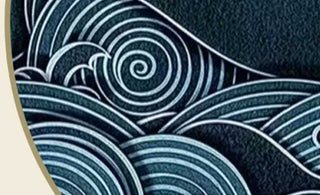
Crafting elegance through Chinese decor techniques is an artistic endeavor that transcends time, inviting a blend of traditional artistry with contemporary sensibilities. This journey into the heart of Chinese decorative arts is not merely about creating aesthetically pleasing spaces but is a deeper exploration into a cultural narrative that is intricately woven with symbolism, harmony, and history. In the world of classical oriental art, a realm of exquisite beauty and cultural significance unfolds. Chinese decor techniques have long captivated the hearts of collectors, artists, and enthusiasts who appreciate the refined elegance of this ancient art form. With a rich heritage and a deep-rooted tradition, Chinese decor techniques embody the essence of craftsmanship and artistic expression. In this article, we embark on a journey to explore the secrets behind crafting elegance in Chinese decor.
The Timeless Beauty of Chinese Porcelain
The genesis of Chinese decor techniques dates back to ancient dynasties, where each era contributed distinct styles and innovations. From the ornate dragon motifs of the Han Dynasty to the refined elegance of the Ming Dynasty, the evolution of these techniques mirrors the socio-cultural transformations of China. These ancient practices, refined over centuries, form the cornerstone of what is today known as traditional Chinese decor. Chinese porcelain, renowned for its delicate beauty and timeless allure, stands as a testament to the mastery of Chinese artisans. Through centuries of refinement, Chinese craftsmen have perfected the art of porcelain making, creating pieces that are not only visually stunning but also steeped in cultural significance. From the Ming Dynasty's iconic blue and white designs to the vibrant colors of the Qing Dynasty, Chinese porcelain reflects the rich history and artistic sensibilities of the nation. The intricate patterns and motifs adorning each porcelain creation tell stories of tradition, myth, and nature, transporting us to a bygone era of elegance and refinement.
The Exquisite Artistry of Lacquerware
Lacquerware, with its lustrous finish and intricate designs, embodies the fusion of art and craftsmanship in Chinese decor. Chinese lacquerware is a distinctive technique involving the application of multiple layers of lacquer to create a highly polished, durable finish. This technique is often combined with intricate inlay work using materials like mother-of-pearl, gold, or jade, creating exquisite decorative pieces that are both striking and resistant to moisture and decay. This ancient technique involves the application of layers of natural lacquer onto various surfaces, resulting in durable and visually captivating pieces of art. Chinese artisans skillfully carve, paint, or inlay materials into the lacquer, creating breathtaking designs that range from intricately decorated boxes and screens to furniture and tableware. Each lacquerware masterpiece showcases the meticulous attention to detail and the artistic vision of its creator, adding an aura of sophistication to any space.
The Poetic Charm of Chinese Calligraphy
Chinese calligraphy, often referred to as "the art of the brush," is a captivating form of expression that combines aesthetic beauty with profound meaning. Each stroke of the brush carries with it a sense of rhythm and harmony, bringing characters to life on paper or silk scrolls. Textiles in Chinese decor are rich in symbolism and artistry. Traditional techniques like silk embroidery, which involve intricate stitching and vibrant colors, are used to create stunning tapestries, cushion covers, and curtains. These textiles often depict scenes from nature or mythology, adding both beauty and storytelling to the decor. Chinese calligraphy is not merely a means of communication but a form of art that embodies the essence of the written word. The expressive power of calligraphy lies in its ability to convey emotions, capture the essence of nature, and reflect the wisdom of ancient philosophical teachings. Adorning scrolls and decorative pieces, Chinese calligraphy adds a touch of elegance and poetic charm to any environment. Chinese painting, with its distinctive brushwork and evocative imagery, is a window into the natural world and the inner emotions of the artist. Rooted in Taoist and Buddhist philosophies, Chinese paintings strive to capture the essence of serenity and harmony. Through the skillful use of brush and ink, artists create landscapes, flora, fauna, and human figures that evoke a sense of tranquility and contemplation. The delicate balance between light and shadows, the meticulous attention to detail, and the mastery of brush techniques result in breathtaking works of art that transport viewers to a realm of beauty and introspection.
The Luxurious Art of Silk and Embroidery
Silk, known as the "queen of fabrics," has been synonymous with luxury and elegance for centuries. Chinese silk weaving techniques have been refined over generations, producing exquisite tapestries, garments, and upholstery that epitomize sophistication. Intricate patterns, vibrant colors, and meticulous embroidery make Chinese silk creations a visual feast for the eyes. From silk scrolls adorned with auspicious symbols to elaborately embroidered garments, the allure of silk adds a touch of opulence and refinement to Chinese decor, making it a coveted art form that transcends time.Chinese decor techniques heavily emphasize the use of natural materials like wood, bamboo, silk, and stone. Wood is often intricately carved with traditional motifs, while bamboo represents strength and resilience. Silk, a material historically significant to Chinese culture, is used in textiles and wall hangings, adding a touch of luxury and elegance.
In conclusion, Chinese decor techniques encapsulate the essence of elegance, craftsmanship, and cultural heritage. From the delicate beauty of porcelain to the artistry of lacquerware, the poetic charm of calligraphy, the serenity of painting, and the luxurious allure of silk and embroidery, each technique carries within it centuries of tradition and artistry. At Oriental Aesthetics, we are dedicated to providing systematic, high-quality professional services for oriental artists, collectors, and enthusiasts who share our love for classical oriental art. Through our commitment to preserving and showcasing the magnificence of Chinese decor, we invite you to embark on a journey of discovery into the enchanting world of Chinese aesthetics.























